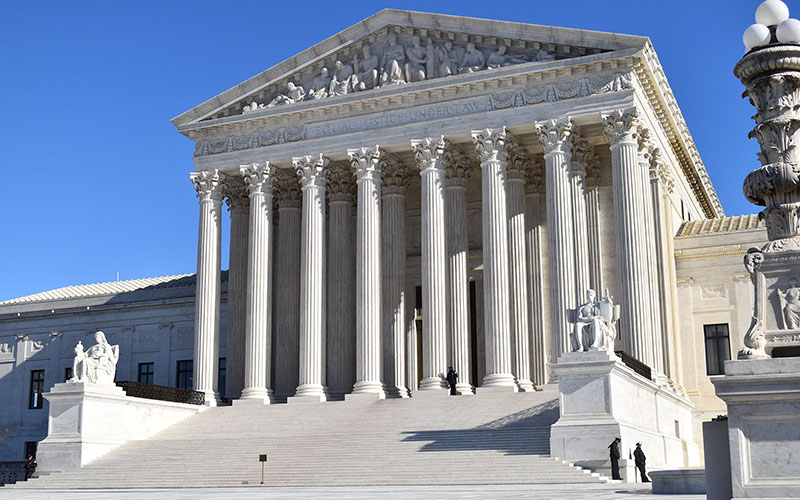WASHINGTON – Supreme Court justices appeared skeptical Wednesday of the notion that Arizona double-murderer James Erin McKinney should get a new sentencing hearing, asking if that would not be a “windfall” for McKinney at the expense of his victims’ families.
McKinney claims that the judge who sentenced him to death for two 1991 Phoenix-area murders failed to consider his troubled childhood and post-traumatic stress disorder, and that subsequent Supreme Court rulings say he should be sentenced by a jury instead.
“The state seeks to put James McKinney to death even though he’s never once had a sentencing proceeding that complies with current law,” said Neal Katyal, the attorney arguing for McKinney. “If McKinney were sentenced today, no one doubts he’d be entitled to a jury trial.”
But the ruling that requires juries to impose sentence in capital cases, Ring v. Arizona, was not handed down until 2002, well after McKinney’s crimes and sentence. Some justices said during Wednesday’s arguments that Ring is not retroactive and asked why it should apply to McKinney’s case now.
“You’re requiring a new jury sentencing 28 years after the murders and after the victims’ families have been through this for three decades,” Justice Brett Kavanaugh said.
McKinney and his half-brother, Charles Hedlund, were convicted by separate Maricopa County juries in 1993 after a string of Phoenix-area burglaries, two of which ended in murders.
At sentencing, Maricopa County Superior Court Judge Steven Sheldon said he considered the defendants’ troubled childhoods but that they did not outweigh factors that argued for the death penalty, including prior convictions and the “especially heinous, cruel or depraved” nature of the killings. He sentenced both to death, sentences upheld by the Arizona Supreme Court in 1996.

James McKinney has been on Arizona’s death row since 1993 for two murders committed with his half-brother during burglaries in the Phoenix area in 1991. (Photo courtesy Arizona Department of Corrections)
But a divided 9th U.S. Circuit Court of Appeals ruled in 2015 that Arizona had wrongly sentenced McKinney using a “causal nexus” standard, which says that mitigating factors like childhood trauma must have a direct link to the crime to be considered.
The U.S. Supreme Court had said in 1982 that all mitigating evidence should be considered in a capital sentencing, but the circuit court said Arizona may have been using the causal nexus standard for as long as 15 years after it was rejected. Advocates say that may have occurred in the sentencing of 19 other inmates currently on Arizona’s death row.
The state argued that McKinney’s case became “final” when it was upheld for the first time by the Arizona Supreme Court in 1996. Rather than begin a new sentencing proceeding after the circuit court ruling, the state Supreme Court did an “independent review” of McKinney’s sentence and upheld it again in 2018, ruling that the mitigating factors still did not outweigh aggravating factors.
But Katyal said a review of McKinney’s sentence was not enough. He said it demanded a “brand-new, full-blown, 100% redo” in 2018 – when Ring would have applied and a jury should have done the sentencing.
Justice Samuel Alito asked if McKinney was not “asking for a windfall” with his demand for a sentencing trial by jury.
“Maybe a double windfall. You are effectively getting retroactive application of Ring, which is not retroactively applicable to anybody else,” Alito said.
He suggested McKinney was hoping for mercy from a jury, looking for “another shot at convincing a jury to hold that somebody who is going to be found death-eligible in all likelihood should, nevertheless, not get the death penalty.”
But other justices asked how the state Supreme Court’s review was not the “redo” Katyal was asking for, and how that would not be subject to Ring.
“It’s a reanalysis of an analysis that was done in the direct proceeding,” Justice Elena Kagan said. “So it’s a redo of the direct proceeding. Whatever you want to call that, it’s a redo of the direct proceeding.”
Arizona Solicitor General Oramel H. Skinner argued that the only way to “undo” McKinney’s sentence and get a redo would be if the circuit court vacated the sentence, which it did not.
“Our position is, once a case is final on direct review, as this was 23 years ago, the touchstone for how you would undo that finality is to vacate the sentence,” Skinner said.
The Arizona Supreme Court “fixed it” by following the direction of the circuit court, he said.
“We went back and looked at the thing identified as a problem, conducted the analysis without a causal nexus, and corrected the identified problem that the 9th Circuit had said occurred in Arizona Supreme Court,” he said.
But Katyal said an appeals court is not the appropriate place to consider aggravating and mitigating factors in a death-penalty case, particularly mitigating factors like McKinney’s PTSD from childhood trauma.
“Because mitigating ones to go mercy, in which this court has said … that’s the thing you need the jury to see, or at least the trial court to see up front and personal, as opposed to on a cold record,” he said.
Arizona Attorney General Mark Brnovich in a statement Wednesday called for sympathy for the victims’ families.
“This is another attempt by a convicted killer to delay accepting responsibility for his heinous crimes,” Brnovich’s statement said, adding that “justice delayed is justice denied.”
Attorneys for both sides declined comment after Wednesday’s arguments. A ruling by the court is not expected until next spring.

